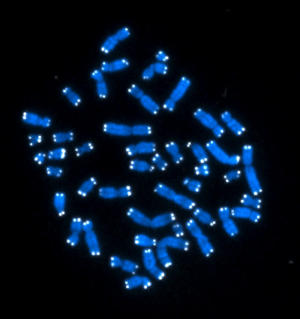摘要:美国国立卫生研究院(National Institutes of Health)的研究人员发现关于正常细胞中设置程序性衰老分子钟的一种新的途径,这项研究有助于了解毒蛋白Progerin和端粒之间的相互作用,端粒是染色体的两端,就像鞋带两端的塑料条一样。

23对染色体
国立人类基因组研究所(NHGRI)的研究人员开展这一研究,相关的论文发表在 Clinical Investigation期刊上。
端粒长度随着细胞分裂逐渐变短,当达到一定限度时,细胞停止分裂并凋亡。研究发现,短的或功能故障的端粒激活毒蛋白Progerin的表达,后者引起与年龄相关的细胞损伤。端粒长度越短,细胞合成的毒蛋白Progerin的量就越多。
毒蛋白Progerin是正常核纤层蛋白A的突变体,核纤层蛋白A是由正常的基因LMNA编码,维持细胞中遗传信息库——细胞核的结构。
2003年,NHGRI研究人员发现,LMNA蛋白变异体引起过早衰老的生理表现——Hutchinson-Gilford 衰老症状,早衰症是一种罕见的疾病,儿童患者表现出与年龄不符的生理特征,如脱发、动脉粥样硬化和骨骼异常等,并在青少年时期死于心血管并发症。
前期,科林(Collins)发现基因突变引起早衰症生,接下来,美国国立卫生研究院的研究阐述该疾病的生化和分子机制。
2007年,NIH研究员指出,即便不发生基因变异,健康人的正常细胞也能合成小量的毒蛋白progrin。细胞分裂次数越多,端粒长度越短,同时progrin蛋白的合成量越多。然而什么因素激发毒蛋白progrin合成?至今还是个谜。
目前研究表明,引起早衰症的基因变异触发核纤层蛋白A转录前体的剪接,毒蛋白progrin随之合成。然而,异常的LMNA剪接也出现在正常基因的表达过程中。
一些研究表明,正常细胞分裂时,变短的端粒在一定程度上改变细胞处理遗传信息的方式,主要表现在蛋白质合成过程中RNA剪接机制。为了合成蛋白质,RNA从嵌入在DNA的遗传信息转录出来,这些遗传信息不是线性连续的,细胞把遗传信息片段——外显子剪接在一起,同时去除间隔的序列——内含子。随着端粒长度变短,这一机制看上去会有所改变,并影响用于维持细胞骨架完整的蛋白质的合成。更为重要的是,RNA剪接机制的改变引起LMNA信使RNA的合成,导致大量毒蛋白progrin在细胞中积累。
生物学和分子遗传所的副教授(马里兰大学)曹刊博士称,细胞衰老过程中,端粒酶的短化在毒蛋白progrin合成方面发挥关键作用,并引起多种基因选择剪接机制的改变。端粒酶是延伸端粒结构的一种酶,细胞借此作用可以保持分裂能力。只要永久供应端粒酶,这类细胞合成很少的毒蛋白progrin,同时具有不死性,大多数这类细胞是癌细胞,表现在:分裂次数不受限。
研究人员认为,端粒丢失和毒蛋白合成共同引起衰老,相关研究揭示了毒蛋白progrin如何参与正常的衰老进程。(生物探索译 Pobee)
生物探索推荐英文原文
New Clues About Aging: Genetic Splicing Mechanism Triggers Both Premature Aging Syndrome and Normal Cellular Aging
National Institutes of Health researchers have identified a new pathway that sets the clock for programmed aging in normal cells. The study provides insights about the interaction between a toxic protein called progerin and telomeres, which cap the ends of chromosomes like aglets, the plastic tips that bind the ends of shoelaces.
The study by researchers from the National Human Genome Research Institute (NHGRI) appears online in the Journal of Clinical Investigation.
Telomeres wear away during cell division. When they degrade sufficiently, the cell stops dividing and dies. The researchers have found that short or dysfunctional telomeres activate production of progerin, which is associated with age-related cell damage. As the telomeres shorten, the cell produces more progerin.
Progerin is a mutated version of a normal cellular protein called lamin A, which is encoded by the normal LMNA gene. Lamin A helps to maintain the normal structure of a cell's nucleus, the cellular repository of genetic information.
In 2003, NHGRI researchers discovered that a mutation in LMNA causes the rare premature aging condition, progeria, formally known as known as Hutchinson-Gilford progeria syndrome. Progeria is an extremely rare disease in which children experience symptoms normally associated with advanced age, including hair loss, diminished subcutaneous fat, premature atherosclerosis and skeletal abnormalities. These children typically die from cardiovascular complications in their teens.
"Connecting this rare disease phenomenon and normal aging is bearing fruit in an important way," said NIH Director Francis S. Collins, M.D., Ph.D., a senior author of the current paper. "This study highlights that valuable biological insights are gained by studying rare genetic disorders such as progeria. Our sense from the start was that progeria had a lot to teach us about the normal aging process and clues about more general biochemical and molecular mechanisms."
Collins led the earlier discovery of the gene mutation responsible for progeria and subsequent advances at NIH in understanding the biochemical and molecular underpinnings of the disease.
In a 2007 study, NIH researchers showed that normal cells of healthy people can produce a small amount of progerin, the toxic protein, even when they do not carry the mutation. The more cell divisions the cell underwent, the shorter the telomeres and the greater the production of progerin. But a mystery remained: What was triggering the production of the toxic progerin protein?
The current study shows that the mutation that causes progeria strongly activates the splicing of lamin A to produce the toxic progerin protein, leading to all of the features of premature aging suffered by children with this disease. But modifications in the splicing of LMNA are also at play in the presence of the normal gene.
The research suggests that the shortening of telomeres during normal cell division in individuals with normal LMNA genes somehow alters the way a normal cell processes genetic information when turning it into a protein, a process called RNA splicing. To build proteins, RNA is transcribed from genetic instructions embedded in DNA. RNA does not carry all of the linear information embedded in the ribbon of DNA; rather, the cell splices together segments of genetic information called exons that contain the code for building proteins, and removes the intervening letters of unused genetic information called introns. This mechanism appears to be altered by telomere shortening, and affects protein production for multiple proteins that are important for cytoskeleton integrity. Most importantly, this alteration in RNA splicing affects the processing of the LMNA messenger RNA, leading to an accumulation of the toxic progerin protein.
Cells age as part of the normal cell cycle process called senescence, which progressively advances through a limited number of divisions in the cell lifetime. "Telomere shortening during cellular senescence plays a causative role in activating progerin production and leads to extensive change in alternative splicing in multiple other genes," said lead author Kan Cao, Ph.D., an assistant professor of cell biology and molecular genetics at the University of Maryland, College Park.
Telomerase is an enzyme that can extend the structure of telomeres so that cells continue to maintain the ability to divide. The study supplied support for the telomere-progerin link, showing that cells that have a perpetual supply of telomerase, known as immortalized cells, produce very little progerin RNA. Most cells of this kind are cancer cells, which do not reach a normal cell cycle end point, and instead replicate out of control.
The researchers also conducted laboratory tests on normal cells from healthy individuals using biochemical markers to indicate the occurrence of progerin-generating RNA splicing in cells. The cell donors ranged in age from 10 to 92 years. Regardless of age, cells that passed through many cell cycles had progressively higher progerin production. Normal cells that produce higher concentrations of progerin also displayed shortened and dysfunctional telomeres, the tell-tale indication of many cell divisions.
In addition to their focus on progerin, the researchers conducted the first systematic analysis across the genome of alternative splicing during cellular aging, considering which other protein products are affected by jumbled instructions as RNA molecules assemble proteins through splicing. Using laboratory techniques that analyze the order of chemical units of RNA, called nucleotides, the researchers found that splicing is altered by short telomeres, affecting lamin A and a number of other genes, including those that encode proteins that play a role in the structure of the cell.
The researchers suggest that the combination of telomere fraying and loss with progerin production together induces cell aging. This finding lends insights into how progerin may participate in the normal aging process.







